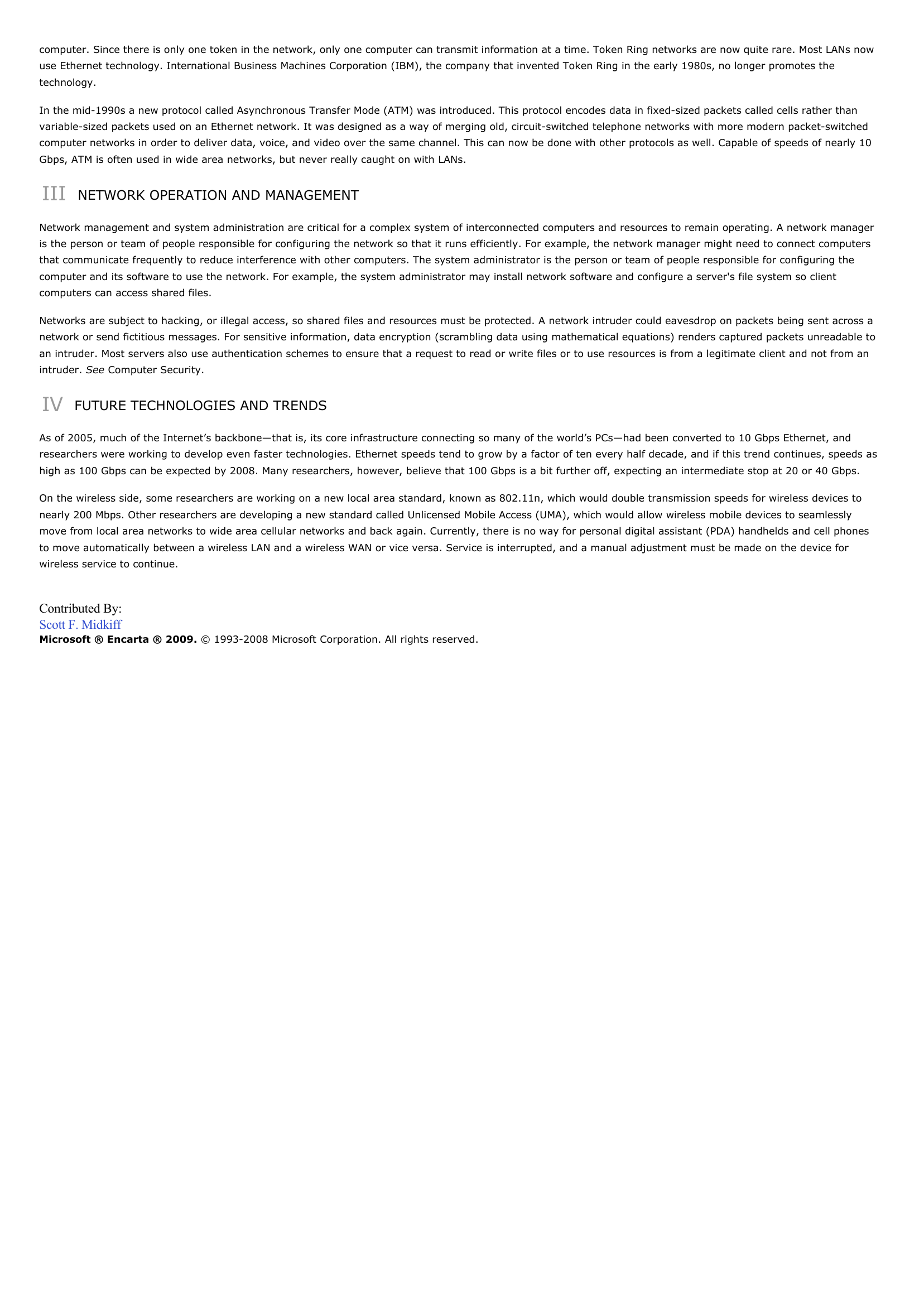Network (computer science).
Publié le 11/05/2013
Extrait du document
«
computer.
Since there is only one token in the network, only one computer can transmit information at a time.
Token Ring networks are now quite rare.
Most LANs nowuse Ethernet technology.
International Business Machines Corporation (IBM), the company that invented Token Ring in the early 1980s, no longer promotes thetechnology.
In the mid-1990s a new protocol called Asynchronous Transfer Mode (ATM) was introduced.
This protocol encodes data in fixed-sized packets called cells rather thanvariable-sized packets used on an Ethernet network.
It was designed as a way of merging old, circuit-switched telephone networks with more modern packet-switchedcomputer networks in order to deliver data, voice, and video over the same channel.
This can now be done with other protocols as well.
Capable of speeds of nearly 10Gbps, ATM is often used in wide area networks, but never really caught on with LANs.
III NETWORK OPERATION AND MANAGEMENT
Network management and system administration are critical for a complex system of interconnected computers and resources to remain operating.
A network manageris the person or team of people responsible for configuring the network so that it runs efficiently.
For example, the network manager might need to connect computersthat communicate frequently to reduce interference with other computers.
The system administrator is the person or team of people responsible for configuring thecomputer and its software to use the network.
For example, the system administrator may install network software and configure a server's file system so clientcomputers can access shared files.
Networks are subject to hacking, or illegal access, so shared files and resources must be protected.
A network intruder could eavesdrop on packets being sent across anetwork or send fictitious messages.
For sensitive information, data encryption (scrambling data using mathematical equations) renders captured packets unreadable toan intruder.
Most servers also use authentication schemes to ensure that a request to read or write files or to use resources is from a legitimate client and not from anintruder.
See Computer Security.
IV FUTURE TECHNOLOGIES AND TRENDS
As of 2005, much of the Internet’s backbone—that is, its core infrastructure connecting so many of the world’s PCs—had been converted to 10 Gbps Ethernet, andresearchers were working to develop even faster technologies.
Ethernet speeds tend to grow by a factor of ten every half decade, and if this trend continues, speeds ashigh as 100 Gbps can be expected by 2008.
Many researchers, however, believe that 100 Gbps is a bit further off, expecting an intermediate stop at 20 or 40 Gbps.
On the wireless side, some researchers are working on a new local area standard, known as 802.11n, which would double transmission speeds for wireless devices tonearly 200 Mbps.
Other researchers are developing a new standard called Unlicensed Mobile Access (UMA), which would allow wireless mobile devices to seamlesslymove from local area networks to wide area cellular networks and back again.
Currently, there is no way for personal digital assistant (PDA) handhelds and cell phonesto move automatically between a wireless LAN and a wireless WAN or vice versa.
Service is interrupted, and a manual adjustment must be made on the device forwireless service to continue.
Contributed By:Scott F.
MidkiffMicrosoft ® Encarta ® 2009. © 1993-2008 Microsoft Corporation.
All rights reserved..
»
↓↓↓ APERÇU DU DOCUMENT ↓↓↓
Liens utiles
- Computer Science.
- LA SCIENCE DE LA LANGUE ET LE STRUCTURALISME
- Peut-on tout attendre de la science ?
- La science ne vise-t-elle que la satisfaction de notre désir de savoir ?
- dissertation philo science et religion: Pourquoi le développement scientifique n'a-t-il pas fait disparaître les religions ?










